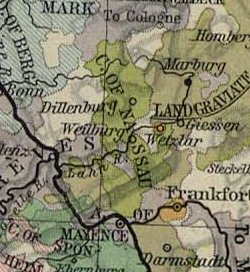| Ruler |
Born |
Reign |
Ruling part |
Consort |
Death |
Notes
|
| Dudo |
|
?
|
1093 – 1117
|
County of Laurenburg/
Nassau |
Irmgard/Demudis of Arnstein
three children
|
c.1117
|
Founder of the family and the county.
|
| Rupert I |
|
c.1090
First son of Dudo and Irmgard/Demudis of Arnstein
|
1117 – 1154
|
County of Laurenburg/
Nassau |
Beatrix of Limburg
before 1135
four children
|
c.1154
aged c.63/64
|
Sons of Dudo, ruled jointly. Arnold abdicated from the co-regency.
|
| Arnold I |
|
c.1090
Second son of Dudo and Irmgard/Demudis of Arnstein
|
1117 – 1148/50 |
Unmarried
|
c.1148/50
aged c.58-60
|
| Rupert II |
|
c.1120
First son of Rupert I and Beatrix of Limburg
|
1154 – 1159
|
County of Laurenburg/
Nassau |
Beatrix
at least two children
|
c.1159
aged c.38-39
|
Sons of Rupert I, ruled jointly.
|
| Arnold II |
|
c.1137
Second son of Rupert I and Beatrix of Limburg
|
Unknown
at least one child
|
c.1159
aged c.21-22
|
| Regency of Beatrix of Limburg (1159-1160)
|
Cousins, ruled together. Rupert III, Arnold II's son, co- ruled with Henry I, Rupert II's son. In 1167, Henry I died in Rome during the August 1167 epidemic (after the Battle of Monte Porzio). His death made his brother Waleran replace him in the co-regency. In 1191, Rupert III's death made his son Herman the new co-regent, but he abdicated the next year. In 1193, Waleran I (then already sole ruler) would become the first legalized Count of Nassau.
|
| Rupert III the Bellicose |
|
c.1130/40?
Son of Arnold II
|
1159 – 23/28 December 1191
|
County of Laurenburg/
Nassau |
Elysa of Leiningen
1169
two children
|
23/28 December 1191
aged c.51-61
|
| Henry I |
|
c.1140
First son of Rupert II and Beatrix
|
1159 – August 1167 |
Unmarried
|
August 1167
Rome
aged c.26/27
|
| Waleran I |
|
1146
Second son of Rupert II and Beatrix
|
August 1167 – 1 February 1198 |
Kunigunde of Ziegenhain
before 1135
four children
|
1 February 1198
aged 51/52
|
| Herman |
|
c.1170
Son of Rupert III and Elysa of Leiningen
|
23/28 December 1191 – 1192 |
Unmarried
|
c.1210?
aged c.39/40?
|
| Henry II the Rich |
|
c.1180
First son of Waleran I and Kunigunde of Ziegenhain
|
1 February 1198 – 26 April 1250
|
County of Nassau |
Matilda of Guelders
before 1221
eleven children
|
26 April 1250
aged c.69/70
|
Sons of Waleran I, ruled together. From 1230 to 1240, Rupert was a Knight of the Teutonic Order.
|
| Rupert IV |
|
c.1180
Second son of Waleran I and Kunigunde of Ziegenhain
|
1 February 1198 – 1230 |
Gertrude of Isenburg-Cleeberg
c. 11 December 1215
no children
|
c.1239
aged c.58/59
|
| Henry II's sons, Waleran II and Otto I, who were ruling together, split the Nassau possessions on 17 December 1255, by a treaty called Prima divisio, which determined the Lahn river as border of the two halves: to the south, called Southern Nassau, was ruled by Waleran and his descendants, who became known as the Walramian Line, which became important in the County of Nassau and Luxembourg; to the north, called Northern Nassau the county was ruled by Otto and his descendants, who became known as the Ottonian Line, which would inherit parts of Nassau, France and the Netherlands.
|
| Waleran II
|
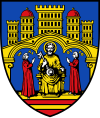
|
c.1220
First son of Henry II and Matilda of Guelders
|
26 April 1250 – 16 December 1255
|
County of Nassau
|
Adelaide of Katzenelnbogen
before 1250
seven children
|
24 January 1276
aged c.55/56
|
Children of Henry II, ruled jointly until 1255, when they issued the Prima divisio, regulating their division of lands:
|
| 16 December 1255 – 24 January 1276 |
Southern Nassau
|
| Otto I
|
1224
Second son of Henry II and Matilda of Guelders
|
26 April 1250 – 16 December 1255
|
County of Nassau
|
Agnes of Leiningen
before 1270
five children
|
between 3 May 1289 and 19 March 1290
aged c.64-66
|
| 16 December 1255 – 1289/90 |
Northern Nassau
|
| Adolph I |

|
1255
Second son of Waleran II and Adelaide of Katzenelnbogen
|
24 January 1276 – 2 July 1298
|
County of Southern Nassau |
Imagina of Isenburg-Limburg
1270
eight children
|
2 July 1298
Göllheim
aged 42/43
|
In 1292 was crowned King of Germany.
|
| Henry I[3]
|

|
c.1270
First son of Otto I, Count of Nassau and Agnes of Leiningen
|
1289/90 – 1303
|
County of Northern Nassau
|
Adelaide of Sponheim-Heinsberg
1302
five children
|
July/August 1343
aged 72/73
|
Sons of Otto I, ruled together until 1303, when they divided the land: Henry received Nassau-Siegen
(Siegen, Ginsberg, Haiger, and the Westerwald), Emicho received Nassau-Hadamar and John received Nassau-Dillenburg. However, after the childless death of John, Nassau-Dillenburg (and the towns of Dillenburg, Herborn, and Beilstein) fell to Nassau-Siegen, which adopted the name Nassau-Dillenburg. Siegen and Dillenburg were united until 1606.
|
| 1303 – July/August 1343 |
County of Siegen
|
| Emicho I
|
|
c.1285
Second son of Otto I, Count of Nassau and Agnes of Leiningen
|
1289/90 – 1303
|
County of Northern Nassau
|
Anna of Nuremberg
before 1297
eight children
|
7 June 1334
aged 48-49
|
| 1303 – 7 June 1334 |
County of Hadamar
|
| John
|
|
c.1285
Fourth son of Otto I, Count of Nassau and Agnes of Leiningen
|
1289/90 – 1303
|
County of Northern Nassau
|
Unmarried
|
10 August 1328
aged 42-43
|
| 1303 – 10 August 1328 |
County of Dillenburg
|
| Nassau-Dillenburg was annexed to Nassau-Siegen
|
| Imagina of Isenburg-Limburg |

|
1255
Limburg an der Lahn
Daughter of Gerlach IV, Count of Isenburg-Limburg and Imagina of Blieskastel
|
2 July 1298 – 29 September 1313
|
County of Southern Nassau
(at Weilburg) |
Adolph I
1270
eight children
|
29 September 1313
Wiesbaden
aged 57–58
|
While Adolf's widow, Imagina, received a seat at Weilburg (which after her death returned to the family), the children of the couple ruled jointly. Waleran abdicated in 1316, and in 1344 Gerlach did the same to pass the rule to his two elder sons, as his brothers didn't have male heirs.
|
| Rupert V |
|
1280
Second son of Adolph I and Imagina of Isenburg-Limburg
|
2 July 1298 – 2 November 1304
|
County of Southern Nassau |
Unmarried
|
2 November 1304
aged 23/24
|
| Gerlach I |
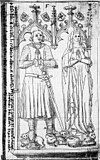
|
1285
Third son of Adolph I and Imagina of Isenburg-Limburg
|
2 July 1298 – 1344 |
Agnes of Hesse
1307
seven children
Irmgard of Hohenlohe-Weikersheim
before 4 January 1337
two children
|
7 January 1361
Wiesbaden-Sonnenberg (?)
aged 75/76
|
| Waleran III |
|
1294
Fifth son of Adolph I and Imagina of Isenburg-Limburg
|
2 July 1298 – 1316 |
Unmarried
|
22 December 1324
aged 29/30
|
| John |
|
c.1305
First son of Emicho I and Anna of Nuremberg
|
7 June 1334 – 20 January 1365
|
County of Hadamar |
Elisabeth of Waldeck
1331
ten children
|
20 January 1365
aged c.59/60
|
Children of Emicho I, ruled jointly.
|
| Emicho II |
|
c.1305
Second son of Emicho I and Anna of Nuremberg
|
7 June 1334 – 1 March 1359 |
Anna of Diez
no children
|
1 March 1359
aged c. 53/54
|
| Otto II |

|
1305
First son of Henry I and Adelaide of Sponheim-Heinsberg
|
July/August 1343 – December 1350 or January 1351
|
County of Siegen |
Adelaide of Vianden
23 December 1331
three children
|
December 1350/January 1351
|
Children of Henry I, divided the land: Otto inherited Siegen and Dillenburg, and Henry inherited Beilstein, partitioned from Dillenburg.
|
| Henry I |
|
1307
Second son of Henry I and Adelaide of Sponheim-Heinsberg
|
July/August 1343 – 28 October 1378
|
County of Beilstein |
Imagina of Westerburg
1339
three children
|
28 October 1378
Beilstein
aged 70/71
|
| Adelaide of Vianden |

|
c.1310
Daughter of Philip II, Count of Vianden and Adelaide of Arnsberg
|
December 1350 or January 1351 – 30 September 1376
|
County of Siegen
(in Mengerskirchen and Tringenstein) |
Otto II
23 December 1331
three children
|
30 September 1376
Mengerskirchen (?)
aged c.65/66
|
Heirs of Otto II. Adelaide, as Otto's widow, received seats Mengerskirchen and Tringenstein, while serving also as regent for her son John. After John attained majority, she continued her rule in her designated seats. During his long reign, John made lucrative acquisitions of various kinds and expanded the possessions of his family.
|
| Regency of Adelaide of Vianden (1351-1362)
|
| John I |
|
1339
Son of Otto II and Adelaide of Vianden
|
December 1350 or January 1351 – 4 September 1416
|
County of Siegen |
Margaret of the Mark
30 November 1357
five children
|
4 September 1416
Herborn
aged 76/77
|
| Adolph I
|

|
1307
First son of Gerlach I, Count of Nassau and Agnes of Hesse
|
1344 – 25 November 1355
|
County of Southern Nassau
|
Margaret of Nuremberg
1322
fourteen children
|
17 January 1370
Idstein
aged 62/63
|
Children of Gerlach I. The eldest two (Adolph and John) ruled first together in Nassau. In 1355, they formalized a division of the land between them and their other brothers:
- Adolph inherited Idstein and passed it to his descendants.
- John inherited Weilburg and passed it to his descendants.
- Crato inherited Sonnenberg, died with no descendants, and was succeeded by his brother Rupert.
- Rupert inherited his brother Crato's land of Sonnenberg, and, with no children left, passed it to his wife Anna.
|
| 25 November 1355 – 17 January 1370 |
County of Idstein
|
| John I
|

|
1309
Second son of Gerlach I, Count of Nassau and Agnes of Hesse
|
1344 – 25 November 1355
|
County of Southern Nassau
|
Gertrude of Merenberg
1333
one child
Johanna of Saarbrücken
1353
seven children
|
20 September 1371
Weilburg
aged 61/62
|
| 25 November 1355 – 20 September 1371 |
County of Weilburg
|
| Crato |
|
c.1340
First son of Gerlach I, Count of Nassau and Irmgard of Hohenlohe-Weikersheim
|
25 November 1355 – 19 September 1356
|
County of Sonnenberg |
Unmarried
|
19 September 1356
Poitiers
aged c.15/16
|
| Rupert (VI) the Warrior |
|
c.1340
Second son of Gerlach I, Count of Nassau and Irmgard of Hohenlohe-Weikersheim
|
19 September 1356 – 4 September 1390
|
County of Sonnenberg |
Anna of Nassau-Hadamar
1362
no children
|
4 September 1390
Kirchheimbolanden
aged c.49/50
|
| Elisabeth of Waldeck |
|
c.1305
Daughter of Henry IV, Count of Waldeck and Adelaide of Cleves
|
1365 – 1381
|
County of Hadamar
(at Ems) |
John
1331
ten children
|
c.1381
Ems (?)
aged 75/76
|
Heirs of John. Elisabeth, as widow, ruled at Ems; the county was shared by their two children: Henry and Emicho. The mental disorder of Emicho led to an establishment of a regency led by his brother-in-law, Rupert, Count of Nassau-Sonnenberg, and probably then his widow, Emicho's sister Anna. Neither Emicho nor Henry left descendants, and the county was thus inherited by Anna.
|
| Henry |
|
c.1335
Hadamar
Fourth son of John and Elisabeth of Waldeck
|
1365 – 1368
|
County of Hadamar
|
Unmarried
|
1368
Hadamar
aged c. 32/33
|
| Emicho III |
|
c.1335
Hadamar
Fifth son of John and Elisabeth of Waldeck
|
1365 – 1394
|
1394
Hadamar
aged c. 58/59
|
| Gerlach II |

|
1333
First son of Adolph I and Margaret of Nuremberg
|
17 January 1370 – 1386
|
County of Idstein |
Agnes of Veldenz
c.1360
no children
|
1386
Idstein (?)
aged 52/53
|
Children of Adolph I, divided the land: Gerlach kept Idstein and Waleran inherited Wiesbaden. Waleran reunited Idstein after his brother's death.
|
| Waleran IV |

|
1348 or 1354
Sixth son of Adolph I and Margaret of Nuremberg
|
17 January 1370 – 7 November 1393
|
County of Idstein
(At Wiesbaden
1370-86) |
Bertha of Westerburg
1374
two children
|
7 November 1393
Wiesbaden (?)
aged 38/39 or 44/45
|
| Joanna of Saarbrücken |
|
1330
Saarbrücken
First daughter of John II, Count of Saarbrücken and Ghislette of Bar-Pierrefort
|
20 September 1371 – October 1381
|
County of Weilburg
(at Neuweilnau) |
John I, Count of Nassau-Weilburg
1353
seven children
|
October 1381
Neuweilnau (?)
aged 50/51
|
Joanna held her estate at Neuweilnau until her death; while providing the regency for her son on the rest of Weilburg; At his death, Philip would divide the land for his sons: the eldest received Nassau-Weilburg; the youngest, her original county of Saarbrücken.
|
| Regencies of Joanna of Saarbrücken (1371-1381) and Frederick of Blankenheim, Bishop of Strasbourg (1381-1382)
|
| Philip I |
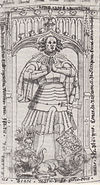
|
1368
Weilburg
Son of John I and Joanna of Saarbrücken
|
20 September 1371 – 2 July 1429
|
County of Weilburg |
Anna of Hohenlohe-Weikersheim
1385
one child
Elisabeth of Lorraine-Vaudémont
1412
four children
|
2 July 1429
Wiesbaden
aged 60/61
|
| Henry II |
|
c.1340
Beilstein
First son of Henry I, Count of Nassau-Beilstein and Imagina of Westerburg
|
24 February 1378 – 12 October 1412
|
County of Beilstein |
Catherine of Randerode
1383
four children
|
12 October 1412
Beilstein
aged 71/72
|
Sons of Henry I, ruled jointly.
|
| Rainhard |
|
c.1345
Beilstein
Second son of Henry I, Count of Nassau-Beilstein and Imagina of Westerburg
|
24 February 1378 – c.1415 |
Unmarried
|
c.1415
aged c.69/70?
|
| Anna
|
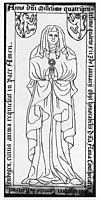
|
c.1350
Hadamar
Second daughter of John, Count of Nassau-Hadamar and Elisabeth of Waldeck
|
4 September 1390 – 21 January 1404
|
County of Sonnenberg
|
Rupert, Count of Nassau-Sonnenberg
1362
no children
|
21 January 1404
Wiesbaden-Sonnenberg
aged 53/54
|
Heir of her husband and her brother. In 1403, renounced the claims over Hadamar and, after her own death, Sonnenberg went to Weilburg line.
|
| 1394-1403 |
County of Hadamar
|
| Nassau-Hadamar was annexed to Nassau-Siegen
|
| Nassau-Sonnenberg was annexed to Nassau-Weilburg
|
| Regency of Bertha of Westerburg (possibly[4]) (1393-c.1400)
|
|
| Adolph II |
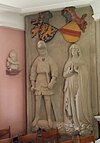
|
1386
Son of Waleran IV, Count of Nassau-Idstein and Bertha of Westerburg
|
7 November 1393 – 16 July 1426
|
County of Idstein |
Margaret of Baden
March 1418
six children
|
16 July 1426
aged 39/40
|
| John I |
|
c.1400?
First son of Henry I and Catherine of Randerode
|
1414/18 – July 1473
|
County of Beilstein |
Matilda of Isenburg-Grenzau
1415
four children
Johanna von Gemen
1477
one child
|
July 1473
aged 72/73
|
Sons of Henry II, ruled jointly.
|
| Henry III |
|
c.1400?
Third son of Henry I and Catherine of Randerode
|
1414/18 – 12 September 1477
|
County of Beilstein |
Unmarried
|
12 September 1477
aged 76/77
|
| Adolph I
|
|
1362
Dillenburg
First son of John I, Count of Nassau-Siegen and Margaret of the Mark
|
1388 – 12 June 1420
|
County of Diez
|
Judith of Diez
(d.14 August 1397)
1384
one child
Kunigunde of Isenburg-Limburg
(d.15 March 1403)
1402
no children
|
12 June 1420
Diez (?)
aged 57/58
|
Sons of John I, ruled jointly, as Tetrarchs. Counts Adolph and Engelbert inherited via his wives half of Diez and Breda, respectively, which became, after their deaths, part of Nassau patrimony.
|
| 4 September 1416 – 1420 |
County of Siegen
|
| John II with the Helmet |
|
c.1365
Dillenburg
Second son of John I, Count of Nassau-Siegen and Margaret of the Mark
|
4 September 1416 – May 1443
|
County of Siegen |
Unmarried
|
May 1443
Dillenburg
|
| Engelbert I
|

|
1370
Dillenburg
Third son of John I, Count of Nassau-Siegen and Margaret of the Mark
|
1403 – 3 May 1442
|
Barony of Breda
|
Johanna van Polanen
1 August 1403
Breda
six children
|
3 May 1442
Breda
aged 71/72
|
| 4 September 1416 – 3 May 1442 |
County of Siegen
|
| John III the Younger |
|
1398
Dillenburg
Fifth son of John I, Count of Nassau-Siegen and Margaret of the Mark
|
4 September 1416 – 18 April 1430
|
County of Siegen |
Unmarried
|
18 April 1430
Siegen (?)aged 31/32
|
| Judith |
|
c.1385
Siegen or Diez
Daughter of Adolf I, Count of Nassau-Siegen and Judith of Diez
|
12 June 1420 – 2 August 1424
|
County of Diez |
Godfried VII, Lord of Eppstein-Münzenberg
1401
five children
|
2 August 1424
aged 38/39
|
Inherited half of Diez (the other part was inherited by her uncles) and after her death passed to the Eppstein family. Nassau-Siegen eventually recovered parts of her share of Diez in 1530.
|
| Diez annexed to County of Eppstein; Recovered to Nassau-Siegen in 1530
|
| Regency of Margaret of Baden (1426-1433)
|
|
| John II |
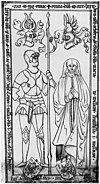
|
1419
Wiesbaden or Idstein
Son of Adolph II and Margaret of Baden
|
16 July 1426 – 9 May 1480
|
County of Idstein |
Maria of Nassau-Siegen
17 June 1437
Breda
six children
|
9 May 1480
Wiesbaden or Idstein
aged 60/61
|
| Regency of Elisabeth of Lorraine-Vaudémont (1429–1438)
|
Sons of Philip I, Philip II and John II divided their inheritance. Philip II was the eldest and received Nassau-Weilburg; John received Saarbrücken. Between 1464 and 1490, Philip II also served as regent for count John Louis in Saarbrücken, together with Duke Eberhard I of Württemberg, following the death of the count's mother and previous regent. Philip II also associated,later in his reign, his own son, John III, who predeceased him.
|
| Philip II |
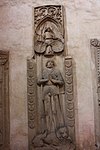
|
12 March 1418
Weilburg
First son of Philip I and Elisabeth of Lorraine-Vaudémont
|
2 July 1429 – 19 March 1492
|
County of Weilburg |
Margaret of Loon-Heinsberg
25 September 1440
two children
Veronica of Sayn-Wittgenstein
1477
no children
|
19 March 1492
Mainz
aged 74
|
| John III |

|
27 June 1441
Weilburg
Son of Philip II and Margaret of Loon-Heinsberg
|
1472 – 15 July 1480 |
Elisabeth of Hesse, the Handsome
1464
two children
|
15 July 1480
Weilburg
aged 39
|
| John II |

|
4 April 1423
Saarbrücken
Second son of Philip I, Count of Nassau-Weilburg and Elisabeth of Lorraine-Vaudémont
|
2 July 1429 – 15 July 1472
|
County of Saarbrücken |
Johanna of Loon-Heinsberg
30 November 1456
two children
Elisabeth of Württemberg-Urach
30 October 1470
one child
|
15 July 1472
Vehingen
aged 49
|
| John IV
|

|
1 August 1410
Breda
First son of Engelbert I and Johanna van Polanen
|
3 May 1442 – 3 February 1475
|
Barony of Breda
|
Mary of Looz-Heinsberg
7 February 1440
six children
|
3 February 1475
Dillenburg
aged 64
|
Sons of Engelbert I, ruled jointly in Breda and Dillenburg until 1447. In this year they divided their lands: John kept Breda and Henry, Dillenburg. After the latter's death, the former reunited their possessions. Their sister Maria inherited some unknown possessions in the Netherlands (possibly in Breda), which she contested with her brother John,[5] and possibly passed to Nassau-Idstein.
|
3 May 1442 – 22 February 1447
18 January 1451 – 3 February 1475 |
County of Siegen
|
| Maria |

|
2 February 1418
Breda
Second daughter of Engelbert I and Johanna van Polanen
|
3 May 1442 – 11 October 1472
|
Barony of Breda |
John II
17 June 1437
Breda
six children
|
11 October 1472
Idstein
aged 54
|
| Henry II
|
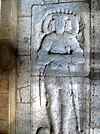
|
7 January 1414
Dillenburg
Second son of Engelbert I and Johanna van Polanen
|
3 May 1442 – 22 February 1447
|
Barony of Breda
|
Genoveva of Virneburg
1435
one child
Irmgard of Schleiden-Junkerath
after 1437
no children
|
18 January 1451
Radicofani
aged 37
|
| 3 May 1442 – 18 January 1451 |
County of Siegen
|
| Margaret |
|
1415
Dillenburg
First daughter of Engelbert I and Johanna van Polanen
|
3 May 1442 – 27 May 1467
|
County of Siegen
(at Burbach) |
Dietrich, Count of Sayn
24 November 1435
no children
|
27 May 1467
aged 51/52
|
| Elisabeth |
|
19 October 1459
Saarbrücken
First daughter of John II and Johanna of Loon-Heinsberg
|
15 July 1472 – 9 March 1479
|
County of Saarbrücken
(at Heinsberg, Diest, Zichem and Zeelhem) |
William IV, Duke of Jülich-Berg
19 October 1472
Saarbrücken
no children
|
9 March 1479
aged 19
|
Children of John II. John Louis inherited the county in general, and his sister Elisabeth received a particular rule over a group of towns, which, after her death with no descendants, was resold by her husband to the House of Nassau, but to the Breda branch.
|
Regencies of Elisabeth of Württemberg-Urach and Eberhard I, Duke of Württemberg (1472-1474),
and Philip II, Count of Nassau-Weilburg (1474-1490)
|
| John Louis |

|
19 October 1472
Saarbrücken
Son of John II and Elisabeth of Württemberg-Urach
|
15 July 1472 – 4 June 1545
|
County of Saarbrücken |
Elisabeth of Palatinate-Zweibrücken
29 January 1492
Saarbrücken
six children
Catharina van Meurs-Saarwerden
14 February 1507
nine children
|
4 June 1545
Saarbrücken
aged 72
|
| Engelbert II the Valorious |
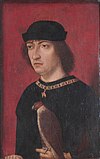
|
17 May 1451
Breda
First son of John IV and Maria of Looz-Heinsberg
|
3 February 1475 – 31 May 1504
|
Barony of Breda |
Cymburgis of Baden
19 December 1468
Koblenz
no children
|
31 May 1504
Brussels
aged 53
|
Children of John IV, divided the land: Engelbert inherited Breda in the Netherlands (with the towns of Lek, Diest, Roosendaal en Nispen, Wouw, and Vianden) and John inherited Dillenburg (with the towns of Dillenburg, Siegen, Hadamar, Herborn, Vianden, Dietz). Both brothers were also Governor of the Habsburg Netherlands: Engelbert was a Stadtholder in Flanders (1499-1506) and Artois (1500-1504); John was Stadtholder in Guelders (1504-1505). Engelbert left no descendants, being succeeded by John's eldest son Henry III.
|
| John V |
|
9 November 1455
Breda
Second son of John IV and Maria of Looz-Heinsberg
|
3 February 1475 – 30 July 1516
|
County of Siegen |
Elisabeth of Hesse-Marburg
11 February 1481
six children
|
30 July 1516
Siegen
aged 60
|
| Henry IV |
|
1449
Beilstein
Son of John I and Johanna von Gemen
|
12 September 1477 – 26 May 1499
|
County of Beilstein |
Eva of Sayn
1464
ten children
|
26 May 1499
Beilstein
aged 49/50
|
|
| Adolph III |
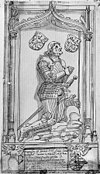
|
10 November 1443
Wiesbaden
Second son of John II and Maria of Nassau-Siegen
|
9 May 1480 – 6 July 1511
|
County of Idstein
(At Wiesbaden
1480-1509) |
Margaret of Hanau-Lichtenberg
20 June 1484
four children
|
6 July 1511
Wiesbaden
aged 67
|
Children of John II, divided the land: Philip kept Idstein and Adolph inherited Wiesbaden. Once more, the holder of Wiesbaden reunited the county. Adolph was also Stadtholder in Guelders (1481-1492).
|
| Philip (I) |
|
1450
Idstein
Fourth son of John II and Maria of Nassau-Siegen
|
9 May 1480 – 16 June 1509
|
County of Idstein
(At Idstein proper) |
Margaret of Palatinate-Zweibrücken
1470
no children
|
16 June 1509
Idstein
aged 58/59
|
| Louis I |

|
1473
Son of John III and Elisabeth of Hesse
|
19 March 1492 – 28 May 1523
|
County of Weilburg |
Maria Margaretha of Nassau-Wiesbaden-Idstein
19 April 1501
six children
|
28 May 1523
Weilburg
aged 49/50
|
|
| John II |
|
1475
Beilstein
First son of Henry IV and Eva of Sayn
|
26 May 1499 – 18 August 1513
|
County of Beilstein |
Maria of Solms-Braunfels
1492
four children
Anna of Lippe
1510
no children
|
18 August 1513
Beilstein
aged 37/38
|
Children of Henry IV, ruled jointly.
|
| Bernard |
|
1479/85
Beilstein
Third son of Henry IV and Eva of Sayn
|
26 May 1499 – 10 May 1556 |
Unmarried
|
10 May 1556
Liebenscheid
aged 70/71 or 76/77
|
| Henry III |
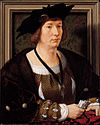
|
12 January 1483
Siegen
First son of John V, Count of Nassau-Siegen and Elisabeth of Hesse-Marburg
|
31 May 1504 – 14 September 1538
|
Barony of Breda |
Louise-Françoise of Savoy
3 August 1503
no children
Claudia of Chalon
May 1515
one child
Mencía de Mendoza
26 June 1524
one child
|
14 September 1538
Breda
aged 55
|
Son of John V, inherited Nassau-Breda from his uncle Engelbrecht II. Also Stadtholder in Holland, Zeeland and Utrecht (1515-1521).
|
| Philip I the Elder |

|
26 April 1492
Cologne
Son of Adolph III and Margaret of Hanau-Lichtenberg
|
6 July 1511 – 1554
|
County of Idstein |
Adriana of Glymes
24 August 1514
Bergen op Zoom
six children
|
6 June 1558
Idstein
aged 66
|
Abdicated for his children, who divided the land once more.
|
| John III |
|
17 November 1495
Beilstein
Son of John II and Maria of Solms-Braunfels
|
10 May 1556 – 13 December 1561
|
County of Beilstein |
Anna of Nassau-Weilburg
1523
no children
|
13 December 1561
Beilstein
aged
|
Ruled with his uncle, Bernard, since 18 August 1513 (his father's death). Had no descendants and after his death the county was annexed to Nassau-Dillenburg.
|
| Nassau-Beilstein merged again in Nassau-Siegen
|
| Elisabeth of Hesse-Marburg |
|
May 1466
Marburg
First daughter of Henry III, Landgrave of Upper Hesse and Anna of Katzenelnbogen
|
30 July 1516 – 7/17 January 1523
|
County of Siegen
(at Tringenstein) |
John V
11 February 1481
six children
|
7 or 17 January 1523
Cologne
aged 56
|
Heirs of John V. William inherited Nassau-Siegen, and gave his mother a seat at Tringenstein. During William's reign (1530), parts of Judith's half of Dietz were recovered. From 1557 he obtained the County of Katznelnbogen.
|
| William I the Rich |

|
10 April 1487
Dillenburg
Fourth son of John V and Elisabeth of Hesse-Marburg
|
30 July 1516 – 6 October 1559
|
County of Siegen |
Walburga of Egmont
29 October 1519
Koblenz
two children
Juliana of Stolberg
29 September 1531
Königstein
twelve children
|
6 October 1559
Dillenburgaged 72
|
| Philip III |
|
20 September 1504
Weilrod
Son of Louis I and Maria Margaretha of Nassau-Idstein
|
28 May 1523 – 4 October 1559
|
County of Weilburg |
Elisabeth of Sayn-Hachenburg
2 March 1523
four children
Anna of Mansfeld-Hinterort
23 September 1536
one child
Amalia of Isenburg-Büdingen
17 August 1541
Büdingen
three children
|
4 October 1559
Weilburg
aged 55 |
|
| René |
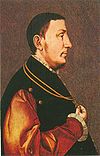
|
5 February 1519
Breda
Son of Henry III and Claudia of Chalon
|
14 September 1538 – 15 July 1544
|
Principality of Orange
(1530–44)
Barony of Breda
(1538–44) |
Anna of Lorraine
22 August 1540
Bar-le-Duc
one child
|
15 July 1544
Saint-Dizier
aged 25
|
Son of Henry III, inherited Nassau-Breda from his father and the Principality of Orange from his mother. He was also Stadtholder in Holland, Zealand and Utrecht (1540-1544).Left no descendants, and gave his patrimony to his cousin.
|
| William I the Silent |

|
24 April 1533
Dillenburg
First son of William I, Count of Nassau-Siegen and Juliane of Stolberg-Wernigerode
|
15 July 1544 – 10 July 1584
|
Principality of Orange
(with Barony of Breda) |
Anna van Egmont
8 July 1551
Buren
three children
Anna of Saxony
24 August 1561
Leipzig
(annulled 14 December 1571)
five children
Charlotte of Bourbon
12 June 1575
Brielle
six children
Louise de Coligny
12 April 1583
Antwerp
one child
|
10 July 1584
Delft
aged 51
|
Eldest son of William the Rich, inherited his cousin's lands, and left his father's inheritance to his younger brothers. Also Count of Katzenelnbogen, Vianden, Dietz, Buren and Leerdam and Lord of IJsselstein, Baron of Breda, etc. He was also Stadtholder in Holland, Zeeland and Utrecht (1559-1567 and 1572-1584) and Frisia and Drenthe (1580-1584). Murdered in 1584.
|
| Philip II |

|
25 July 1509
Saarbrücken
First son of John Louis and Catherine of Moers-Saarwerden
|
4 June 1545 – 19 June 1554
|
County of Saarbrücken |
Apollonia Catherine of Leiningen-Hartenburg
17 July 1535
no children
|
19 June 1554
Strasbourg
aged 44
|
Left no descendants. He was succeeded by his brother.
|
| John III |

|
5 April 1511
Saarbrücken
Second son of John Louis and Catherine of Moers-Saarwerden
|
19 June 1554 – 23 November 1574
|
County of Saarbrücken |
Unmarried
|
23 November 1574
Saarbrücken
aged 63
|
Left no descendants. The land was absorbed by Nassau-Weilburg.
|
| Nassau-Saarbrücken merged again in Nassau-Weilburg
|
| Philip II the Younger |

|
1516
Idstein
First son of Philip I and Adriana of Glymes
|
1554 – 3 January 1566
|
County of Idstein
(At Wiesbaden
1554-56 and 1564–66) |
Unmarried
|
3 January 1566
Wiesbaden-Sonnenberg
aged 49
|
Children of Philip I, divided the land. Adolph kept Idstein and Philip inherited Wiesbaden. After Adolph IV's death, Philip II reunited Idstein, but divided it again with another brother, Balthasar.
|
| Adolph IV |

|
1518
Idstein
Second son of Philip I and Adriana of Glymes
|
1554 – 5 January 1556
|
County of Idstein
(At Idstein) |
Franziska of Luxembourg-Brienne
(1475-17 June 1566)
19 April 1543
four children
|
5 January 1556
Idstein
aged 38
|
| Albert |
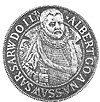
|
26 December 1537
Weilburg
Son of Philip III and Anna of Mansfeld-Hinterort
|
4 October 1559 – 11 November 1593
|
County of Weilburg
(at Weilburg proper) |
Anna of Nassau-Dillenburg
23 September 1536
fourteen children
|
11 November 1593
Ottweiler
aged 55
|
Sons of Philip I, ruled jointly. In 1574 annexed Nassau-Saarbrücken. Philip kept Neuweilnau until his death, which was then reabsorbed in Weilburg.
|
| Philip IV |

|
14 October 1542
Weilburg
Son of Philip III and Amalie of Isenburg-Büdingen
|
4 October 1559 – 12 March 1602
|
County of Weilburg
(at Neuweilnau) |
Erica of Manderscheid-Blankenheim
9 April 1563
one child
Elisabeth of Nassau-Dillenburg
3 October 1583
no children
|
12 March 1602
Saarbrücken
aged 59
|
| John VI the Elder |

|
22 November 1536
Dillenburg
Second son of William I, Count of Nassau-Siegen and Juliane of Stolberg-Wernigerode
|
6 October 1559 – 8 October 1606
|
County of Siegen |
Elisabeth of Leuchtenberg
6 June 1559
Dillenburg
thirteen children
Kunigunde Jakobäa of Palatinate-Simmern
13 September 1580
Dillenburg
four children
Johannetta of Sayn-Wittgenstein
14 June 1586
Berleburg
seven children
|
8 October 1606
Dillenburg
aged 69
|
Younger brother of William the Silent, inherited his father's domains, which were divided after his own death. Also Stadtholder of Guelders (1578-1581).
|
| Balthasar |
|
1520
Idstein
Third son of Philip I and Adriana of Glymes
|
1564 – 11 January 1568
|
County of Idstein
(with Wiesbaden since 1566) |
Margaret of Isenburg-Birstein
(4 December 1542 – 8 August 1613)
9 June/6 September 1564
one child
|
11 January 1568
Idstein
aged 48
|
Brother of Adolph IV and Philip II. Definitely reunited Idstein.
|
| Regency of Margaret of Isenburg-Birstein (1568-1587)
|
|
| John Louis I |

|
10 April 1567
Idstein
Son of Balthasar and Margaret of Isenburg-Birstein
|
11 January 1568 – 10 June 1596
|
County of Idstein |
Maria of Nassau-Siegen
2 December 1588
Idstein
six children
|
10 June 1596
Idstein
aged 29
|
| Philip William |
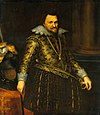
|
19 December 1554
Buren
Son of William I and Anna van Egmont
|
10 July 1584 – 20 February 1618
|
Principality of Orange
(with Barony of Breda) |
Éléonore de Bourbon
23 November 1606
Fontainebleau
no children
|
20 February 1618
Brussels
aged 63
|
Left no descendants. He was succeeded by his half-brother Maurice.
|
| Regency of Maria of Nassau-Siegen (1596-1605)
|
Died as minors. After John Louis' death, his lands were annexed to Nassau-Weilburg.
|
| John Philip |

|
26 March 1595
Idstein
First son of John Louis I and Maria of Nassau-Dillenburg
|
20 June 1596 – 29 August 1599
|
County of Idstein |
Unmarried
|
29 August 1599
Idstein
aged 4
|
| John Louis II |
|
21 May 1596
Idstein
Second son of John Louis I and Maria of Nassau-Dillenburg
|
29 August 1599 – 19 June 1605
|
County of Idstein |
Unmarried
|
19 June 1605
Dillenburg
aged 9
|
| Nassau-Idstein merged again in Nassau-Weilburg
|
| Anna of Nassau-Siegen |
|
21 September 1541
Dillenburg
Third daughter of William I, Count of Nassau-Siegen and Juliane of Stolberg-Wernigerode
|
11 November 1593 – 12 February 1616
|
County of Weilburg
(at Wehen) |
Albert, Count of Nassau-Weilburg
23 September 1536
fourteen children
|
12 February 1616
Weilburg
aged 74
|
Heirs of Albert of Weilburg:
- Anna, his widow, inherited the town of Wehen, which passed to one of her daughters-in-law;
- Louis inherited Ottweiler.
- William inherited Weilburg, which eventually passed to his brother Louis.
- John Casimir inherited Gleiberg, which eventually passed to his brother Louis.
Louis reunited all Southern Nassau under Weilburg, but his sons divided it again.
|
| Louis II |

|
9 August 1565
Weilburg
First son of Albert and Anna of Nassau-Siegen
|
11 November 1593 – 19 November 1597
(as count of Ottweiler)
19 November 1597 – 8 November 1627
(as count of Weilburg)
|
County of Weilburg
|
Anna Maria of Hesse-Kassel
8 June 1589
Kassel
fourteen children
|
8 November 1627
Saarbrücken
aged 62
|
| William |
|
25 August 1570
Weilburg
Fourth son of Albert and Anna of Nassau-Siegen
|
11 November 1593 – 19 November 1597
|
County of Weilburg |
Erica of Isenburg-Birstein
29 January 1596
Birstein
two children
|
19 November 1597
Burgschwalbach
aged 27
|
| John Casimir |
|
24 September 1577
Ottweiler
Fifth son of Albert and Anna of Nassau-Siegen
|
11 November 1593 – 29 March 1602
|
County of Weilburg
(at Gleiberg) |
Elisabeth of Hesse-Darmstadt
10 May 1601
Weilburg
one child
|
29 March 1602
Wehen
aged 24
|
| William Louis |
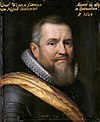
|
13 March 1560
Dillenburg
First son of John VI, Count of Nassau-Siegen and Elisabeth of Leuchtenberg
|
8 October 1606 – 13 July 1620
|
County of Dillenburg |
Anna of Orange-Nassau
25 November 1587
Franeker
no children
|
13 July 1620
Leeuwarden
aged 60
|
Children of John VI, divided the land:
- William Louis received Dillenburg, but left no descendants and was succeeded by his brother George. He was also Stadtholder in Frisia (1584-1620), Groningen (1594-1620), and Drenthe (1596-1620);
- John VII received Siegen, and passed it to his descendants, who divided it once more;
- George received Beilstein, and reunited it with Dillenburg after William Louis' death, passing both to his descendants;
- Ernest Casimir received Dietz, and passed it to his descendants. He was also Stadtholder in Frisia (1620-1632), Groningen and Drenthe (1625-1632);
- John Louis received Hadamar, and passed it to his descendants.
|
| John VII the Middle |
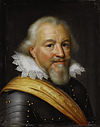
|
7 June 1561
Siegen
Second son of John VI and Elisabeth of Leuchtenberg
|
8 October 1606 – 27 September 1623
|
County of Siegen |
Magdalene of Waldeck-Wildungen
9 December 1581
Dillenburg
twelve children
Margaret of Schleswig-Holstein-Sonderburg
27 August 1603
Dillenburg
thirteen children
|
27 September 1623
Siegen
aged 62
|
| George |

|
1 September 1562
Dillenburg
Third son of John VI, Count of Nassau-Siegen and Elisabeth of Leuchtenberg
|
8 October 1606 – 9 August 1623
|
County of Beilstein
(1606–23)
County of Dillenburg
(1620–23) |
Anna Amalia of Nassau-Saarbrücken
1584
fourteen children
Amalia of Sayn-Wittgenstein
1605
one child
|
9 August 1623
Dillenburg
aged 60
|
| Ernest Casimir |

|
22 December 1573
Dillenburg
Sixth son of John VI, Count of Nassau-Siegen and Elisabeth of Leuchtenberg
|
8 October 1606 – 2 June 1632
|
County of Dietz |
Sophia Hedwig of Brunswick-Lüneburg
8 June 1607
Dillenburg
two children
|
2 June 1632
Roermond
aged 58
|
| Regency of George II, Count of Sayn-Wittgenstein and John Albert I, Count of Solms-Braunfels (1606-1617)
|
| John Louis |

|
6 August 1590
Dillenburg
Second son of John VI, Count of Nassau-Siegen and Johannetta of Sayn-Wittgenstein
|
8 October 1606 – 10 March 1653
|
County of Hadamar
(1606–50)
Principality of Hadamar
(1650–53) |
Ursula of Lippe
1617
fourteen children
|
10 March 1653
Hadamar
aged 62
|
| Elisabeth of Hesse-Darmstadt |
|
29 November 1579
Darmstadt
Second daughter of George I, Landgrave of Hesse-Darmstadt and Magdalene of Lippe
|
12 February 1616 – 17 July 1655
|
County of Weilburg
(at Wehen) |
John Casimir, Count of Nassau-Gleiberg
10 May 1601
Weilburg
one child
|
17 July 1655
Wehen
aged 48
|
Widow of John Casimir, inherited from her mother-in-law her seat at Wehen. At her death, Wehen was inherited by Nassau-Idstein.
|
| Maurice |

|
14 November 1567
Dillenburg
Second son of William I and Anna of Saxony
|
20 February 1618 – 23 April 1625
|
Principality of Orange
(with Barony of Breda) |
Unmarried
|
23 April 1625
The Hague
aged 57
|
He was also Stadtholder in Holland, Zeeland and Utrecht (1584-1625), Guelders and Overjissel (1590-1625) and Groningen and Drenthe (1620-1625). Left no descendants. He was succeeded by his half-brother Frederick Henry.
|
| John VIII the Younger |

|
29 September 1583
Dillenburg
Second son of John VII and Magdalene of Waldeck-Wildungen
|
27 September 1623 – 27 July 1638
|
County of Siegen
(Catholic branch) |
Ernestine Yolande de Ligne
13 August 1618
Brussels
thirteen children
|
27 July 1638
Ronse
aged 54
|
Sons of John VII, divided the land once more, this time in religious matters:
- John VIII converted to Catholicism and received the part of the county south of the river Sieg and the original castle in Siegen (which after 1695 was called the "Upper Castle").
- John Maurice remained Protestant, and received the part of the county north of the Sieg, and was also governor of Dutch Brazil and later of the Prussian province of Cleves, Mark, and Ravensberg. He also conquered the Freudenberg and Netphen districts from his half-brother John VIII, but lost them again four years later. Between 1638 and 1674, his brother George Frederick of Nassau-Siegen ruled his part of the country.
- William received the district of Hilchenbach from John VIII, and also the Ferndorf and Krombach districts 1632–1636. After his own death his districts went back to the Catholic main line.
|
| William |

|
13 August 1592
Dillenburg
Fifth son of John VII and Magdalene of Waldeck-Wildungen
|
1624 – 17 July 1642
|
County of Siegen
(Protestant branch, at Hilchenbach) |
Christiane of Erbach
17 January 1619
Siegen
seven children
|
17 July 1642
Orsoy
aged 49
|
| John Maurice the Brazilian |

|
17 June 1604
Dillenburg
First son of John VII and Margaret of Schleswig-Holstein-Sonderburg
|
1632 – 20 December 1679
|
County of Siegen
(Protestant branch, 1632–64)
Principality of Siegen
(Protestant branch, 1664–79) |
Unmarried
|
20 December 1679
Kleve
aged 75
|
| Louis Henry |

|
9 May 1594
Saarbrücken
Sixth son of George and Anna Amalia of Nassau-Saarbrücken
|
9 August 1623 – 12 July 1662
|
County of Dillenburg
(1623–54)
Principality of Dillenburg
(1654–62) |
Catherine of Sayn-Wittgenstein
1615
twelve children
Elizabeth of Salm-Dhaun
1653
no children
Sophia Margaretha of Nassau-Hadamar
1656
three children
|
12 July 1662
Dillenburg
aged 68
|
Sons of George, ruled jointly.
|
| Albert |

|
1 November 1596
Dillenburg
Eighth son of George and Anna Amalia of Nassau-Saarbrücken
|
9 August 1623 – 16 June 1626 |
County of Dillenburg |
Unmarried
|
16 June 1626
Quakenbrück
aged 29
|
| Frederick Henry |
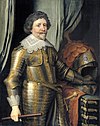
|
29 January 1584
Delft
Son of William I and Louise de Coligny
|
23 April 1625 – 14 March 1647
|
Principality of Orange
(with Barony of Breda) |
Amalia of Solms-Braunfels
4 April 1625
The Hague
nine children
|
14 March 1647
The Hague
aged 63
|
He was also Stadtholder in Holland, Zeeland, Utrecht, Guelders and Overjissel (1625-1647) and Groningen and Drenthe (1640-1647).
|
| William Louis |
|
18 December 1590
Ottweiler
First son of Louis II, Count of Nassau-Weilburg and Anna Maria of Hesse-Kassel
|
8 November 1627 – 22 August 1640
|
County of Saarbrücken |
Anna Amalia of Baden-Durlach
25 November 1615
Durlach
twelve children
|
22 August 1640
Metz
aged 49
|
Children of Louis II, divided the land:
- William Louis received Saarbrücken;
- John received Idstein, and (from 1651) Wiesbaden, Sonnenberg, Wehen, Burg-Schwalbach and Lahr. From 1675 he also served as regent for his nephew, John Ernest of Weilburg.
- Ernest Casimir received Weilburg.
|
| John |

|
24 November 1603
Saarbrücken
Seventh son of Louis II, Count of Nassau-Weilburg and Anna Maria of Hesse-Kassel
|
8 November 1627 – 23 May 1677
|
County of Idstein |
Sibylla Magdalena of Baden-Durlach
6 June 1629
Strasbourg
nine children
Anna of Leiningen-Dagsburg-Falkenburg
6 December 1646
Strasbourg
seventeen children
|
23 May 1677
Idstein
aged 73
|
| Ernest Casimir |
|
15 November 1607
Saarbrücken
Eighth son of Louis II and Anna Maria of Hesse-Kassel
|
8 November 1627 – 16 April 1655
|
County of Weilburg |
Anna Maria of Sayn-Wittgenstein-Hachenburg
22 February 1634
Weilburg
six children
|
16 April 1655
Weilburg
aged 47
|
| Henry Casimir I |

|
21 January 1612
Arnhem
Fourth son of Ernest Casimir I and Sophie Hedwig of Brunswick-Wolfenbüttel
|
2 June 1632 – 13 July 1640
|
County of Dietz |
Unmarried
|
13 July 1640
Hulst
aged 28
|
Also Stadtholder in Frisia, Groningen and Drenthe. Left no descendants. He was succeeded by his brother.
|
| Regency of Ernestine Yolande de Ligne (1638-1651)
|
Had to cede a part of the county to the Protestant branch of the family in 1648. He kept fighting his Protestant neighbours and suppressing the Calvinists in his territory. His reign was marked by bad management and debts. However, in 1652, he was elevated to Imperial Prince. He was also Stadtholder in Limburg (1665-1684) and Upper Guelders (1680-1699).
|
| John Francis Desideratus |

|
28 July 1627
Nozeroy
Son of John VIII and Ernestine Yolande de Ligne
|
27 July 1638 – 17 November 1699
|
County of Siegen
(Catholic branch, 1638–52)
Principality of Siegen
(Catholic branch, 1652–99) |
Johanna Claudia of Königsegg-Rotenfels-Aulendorf
14 May 1651
Vienna
ten children
Marie Eleonore Sophie of Baden-Rodemachern
31 May 1665
Rodemachern
four children
Isabella Clara du Puget de la Serre
9 February 1669
Brussels
ten children
|
17 November 1699
Roermond
aged 72
|
| William Frederick |

|
7 August 1613
Arnhem
Fourth son of Ernest Casimir I and Sophie Hedwig of Brunswick-Wolfenbüttel
|
13 July 1640 – 31 October 1664
|
County of Dietz
(1632–54)
Principality of Dietz
(1654–64) |
Albertine Agnes of Orange-Nassau
2 May 1652
Kleve
three children
|
31 October 1664
Leeuwarden
aged 51
|
Also Stadtholder in Frisia (1640-1664), Groningen and Drenthe (1650-1664).
|
| Regency of Anna Amalia of Baden-Durlach (1638-1642)
|
Anna Amalia exerted regency of her son Crato, and, after his death, took the County of Saarwerden, while regent in the name of her second son in Saarbrücken. After her death, Saarwerden reunited with Saarbrücken. In 1659, John Louis divided the land with his other brothers, in which he received Ottweiler. Count of Nassau-Saarbrücken and (1659–80) in Ottweiler, Jungenheim, and Wöllstein. Between 1677 and 1680 he also served as regent for Count John Ernest of Nassau-Weilburg.
|
| Crato |
|
7 April 1621
Second son of William Louis, Count of Nassau-Saarbrücken and Anna Amalia of Baden-Durlach
|
22 August 1640 – 25 July 1642
|
County of Saarbrücken |
Unmarried
|
25 July 1642
|
| Anna Amalia of Baden-Durlach |
|
9 July 1595
Durlach
Second daughter of George Frederick, Margrave of Baden-Durlach and Juliana Ursula of Salm-Neuville
|
25 July 1642 – 18 November 1651 |
County of Saarbrücken
(at Saarwerden) |
William Louis, Count of Nassau-Saarbrücken
25 November 1615
Durlach
twelve children
|
18 November 1651
Saarbrücken
aged 56
|
| Regency of Anna Amalia of Baden-Durlach (1642-1651)
|
| John Louis
|
|
23 May 1625
Saarbrücken
Third son of William Louis, Count of Nassau-Saarbrücken and Anna Amalia of Baden-Durlach
|
25 July 1642 – 1659
|
County of Saarbrücken
|
Dorothea Catherine of Palatinate-Bischweiler
6 October 1649
Bischweiler
eight children
|
9 February 1690
Reichelsheim
aged 64
|
| 1659 – 9 February 1690 |
County of Ottweiler
|
| William II
|

|
27 May 1626
The Hague
Son of Frederick Henry and Amalia of Solms-Braunfels
|
14 March 1647 – 6 November 1650
|
Principality of Orange
(with Barony of Breda)
|
2 May 1641
London
one child
|
6 November 1650
The Hague
aged 24 |
He was also Stadtholder in Holland, Zeeland, Utrecht, Guelders, Overjissel, Groningen and Drenthe.
|
| Mary of Great Britain
|
4 November 1631
Westminster, London
First daughter of Charles I of England and Henrietta Maria of France
|
6 November 1650 – 24 December 1660
|
Barony of Breda
|
24 December 1660
Westminster, London
aged 29 |
Given her inherited seat in Breda, she may have had the entire hereditary barony, which passed then to her son.
|
| Regencies of Mary of Great Britain (1650-1660) and Amalia of Solms-Braunfels (1650-1672)
|
Also Stadtholder in Holland, Zeeland and Utrecht (1672-1702), Guelders and Overjissel (1675-1702), and Drenthe (1696-1702). Became King of England and Scotland (Great Britain) in 1688, jointly with his wife. Left no descendants. He named his cousin John William Friso of Nassau-Dietz as his heir in The Netherlands and the principality of Orange, passing over the claims of the Hohenzollerns of Brandenburg/Prussia.
|
| William III |

|
4 November 1650
The Hague
Son of William II and Mary of Great Britain
|
6 November 1650 – 8 March 1702
|
Principality of Orange
(with Barony of Breda from 1660) |
Mary II, Queen of Great Britain
4 November 1677
Kensington, London
no children
|
8 March 1702
London
aged 51
|
| Principality of Orange (and Breda) inherited by Nassau-Dietz
|
|
In 1702, the Nassau-Dietz branch followed the House of Orange that had become extinct with William III of England (d. 1702). The counts of Nassau-Dietz not only descended from William the Silent's brother, but in female line also from himself, as William Frederick, Prince of Nassau-Dietz, had married Countess Albertine Agnes of Nassau, the fifth daughter of Frederick Henry, Prince of Orange in 1652.
|
| Maurice Henry |

|
23 April 1626
Hadamar
Son of John Louis and Ursula of Lippe
|
10 March 1653 – 24 January 1679
|
Principality of Hadamar |
Ernestine Charlotte of Nassau-Siegen
30 January 1650
Siegen
six children
Maria Leopoldine of Nassau-Siegen
12 August 1669
Siegen
three children
Anna Louise of Manderscheid-Blankenheim
24 October 1675
Hachenburg
six children
|
24 January 1679
Hadamar
aged 52 |
|
| Frederick |
|
26 April 1640
Metz
Son of Ernest Casimir and Anna Maria of Sayn-Wittgenstein-Hachenburg
|
16 April 1655 – 8 September 1675
|
County of Weilburg |
Christiane Elisabeth von Sayn-Wittgenstein-Homburg
26 May 1663
three children
|
8 September 1675
Weilburg
aged 35 |
|
| Gustav Adolph |

|
27 March 1632
Saarbrücken
Fifth son of William Louis, Count of Nassau-Saarbrücken and Anna Amalia of Baden-Durlach
|
1659 – 9 October 1677
|
County of Saarbrücken |
Eleonora Clara of Hohenlohe-Neuenstein
14 June 1662
seven children
|
9 October 1677
Strasbourg
aged 45
|
Brothers of John Louis of Nassau-Saarbrücken (who retired to rule Ottweiler only), they divided the land: Gustav kept Saarbrücken, and Waleran inherited Usingen.
|
| Walrad |

|
25 February 1635
Roermond
Seventh son of William Louis, Count of Nassau-Saarbrücken and Anna Amalia of Baden-Durlach
|
1659 – 17 October 1702
|
County of Usingen
(1659–88)
Principality of Usingen
(1688-1702) |
Catherine Françoise of Croÿ-Roeulx
16 June 1678
Mechelen
three children
Magdalena Elizabeth of Löwenstein-Wertheim-Rochefort
1686
no children
|
17 October 1702
Usingen
aged 66
|
| Henry |
|
28 August 1641
Dillenburg
Son of George Louis, Heir of Dillenburg and Anna Augusta of Brunswick-Wolfenbüttel
|
12 July 1662 – 18 April 1701
|
Principality of Dillenburg |
Dorothea Elizabeth of Brzeg
13 October 1663
sixteen children
|
18 April 1701
Ludwigsbrunn im Tiergarten
aged
|
Henry was a grandson of Louis Henry, as son of George Louis, Heir of Nassau-Dillenburg. Adolph, son of Louis Henry, ruled at Holzappel and Schaumburg. Adolph passed his fief to his youngest daughter.
|
| Adolph |

|
23 January 1629
Dillenburg
Son of Louis Henry and Catherine of Sayn-Wittgenstein
|
12 July 1662 – 19 December 1676
|
Principality of Dillenburg
(at Schaumburg) |
Elisabeth Charlotte, Countess of Holzappel
1653
eight children
|
19 December 1676
Hadamar
aged 47
|
| Regency of Albertine Agnes of Orange-Nassau (1664-1677)
|
Also Stadtholder in Frisia, Groningen and Drenthe.
|
| Henry Casimir II |

|
18 January 1657
The Hague
Son of William Frederick and Albertine Agnes of Orange-Nassau
|
31 October 1664 – 25 March 1696
|
Principality of Dietz |
Henriëtte Amalia of Anhalt-Dessau
26 November 1683
Dessau
nine children
|
25 March 1696
Leeuwarden
aged 39
|
| Regencies of John, Count of Nassau-Idstein (1675-1677) and John Louis, Count of Nassau-Ottweiler (1677-1680)
|
|
| John Ernest |

|
13 June 1664
Weilburg
Son of Frederick and Christiane Elisabeth of Sayn-Wittgenstein
|
8 September 1675 – 27 February 1719
|
County of Weilburg |
Maria Polyxena of Leiningen-Dagsburg-Hartenburg
3 April 1683
nine children
|
27 February 1719
Heidelberg
aged 54
|
| Regency of Elisabeth Charlotte, Countess of Holzappel (1676-1690)
|
Youngest daughter of Adolf, was his heiress to the lordship of Schuaumburg, which through her marriage was inherited by Anhalt.
|
| Charlotte |
|
28 September 1673
Northrhine-Westphalia
Sixth daughter of Adolph and Elisabeth Charlotte, Countess of Holzappel
|
19 December 1676 – 31 January 1700 |
Principality of Dillenburg
(at Schaumburg) |
Lebrecht, Prince of Anhalt-Zeitz-Hoym
12 April 1692
Schaumburg
five children
|
31 January 1700
Bernburg
aged 27
|
| Schaumburg annexed to Anhalt-Bernburg-Schaumburg-Hoym
|
| Louis Crato |

|
28 March 1663
Saarbrücken
First son of Gustav Adolph and Eleonora Clara of Hohenlohe-Neuenstein
|
9 October 1677 – 14 February 1713
|
County of Saarbrücken |
Philippine Henriette of Hohenlohe-Langenburg
25 April 1699
eight children
|
14 February 1713
Saarbrücken
aged 49
|
Left no male descendants. He was succeeded by his brother Charles Louis.
|
| George August |

|
26 February 1665
Idstein
Son of John and Anna of Leiningen-Dagsburg
|
23 May 1677 – 26 October 1721
|
County of Idstein
(1677–88)
Principality of Idstein
(1688-1721) |
Henriette Dorothea of Oettingen
22 September 1688
Kirchheim unter Teck
twelve children
|
26 October 1721
Biebrich
aged 66 |
|
| Nassau-Idstein was annexed by Nassau-Saarbrücken
|
| Regency of Francis Bernard of Nassau-Hadamar (1679-1694)
|
Left no surviving descendants, and his lands were divided by Nassau-Siegen, Nassau-Dillenburg and Nassau-Diez in 1717.
|
| Francis Alexander |

|
27 January 1674
Hadamar
Son of Maurice Henry and Maria Leopoldine of Nassau-Siegen
|
24 January 1679 – 27 May 1711
|
Principality of Hadamar |
Elizabeth Catherine Felicitas of Hesse-Rotenburg
18 October 1695
Lovosice
(annulled 1705)
fourteen children
|
27 May 1711
Hadamar
aged 37
|
| Nassau-Hadamar divided between Nassau-Dietz, Nassau-Dillenburg and Nassau-Siegen
|
| William Maurice |

|
18/28 January 1649
Terbog
|
20 December 1679 – 23 January 1691
|
Principality of Siegen
(Protestant branch) |
Ernestine Charlotte of Nassau-Schaumburg
6 February 1678
Schaumburg
two children
|
23 January 1691
Siegen
aged 41/42 |
|
| Regency of Ernestine Charlotte of Nassau-Schaumburg (1691-1701)
|
|
| Frederick William Adolf |

|
20 February 1680
Siegen
Son of William Maurice and Ernestine Charlotte of Nassau-Schaumburg
|
23 January 1691 – 13 February 1722
|
Principality of Siegen
(Protestant branch)
|
Elisabeth Juliana Francisca of Hesse-Homburg
7 January 1702
five children
Amalie Louise of Courland
13 April 1708
eight children
|
13 February 1722
Siegen
aged 41
|
| Regency of Henriëtte Amalia of Anhalt-Dessau (1696-1708)
|
In 1702 became the heir of William III of Orange and thus the founder of the younger House of Orange-Nassau and of the Dutch royal family. However, he had to split the Dutch properties with the King of Prussia who also descended from William I. Also Stadtholder in Frisia and Groningen.
|
| John William Friso
|
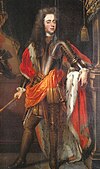
|
14 August 1687
Dessau
Son of Henry Casimir II and Henriëtte Amalia of Anhalt-Dessau
|
25 March 1696 – 14 July 1711
|
Principality of Dietz
(as Nassau-Dietz, 1696–1702; as Orange-Nassau, 1702–11)
Principality of Orange
Barony of Breda
(as Orange-Nassau, 1702–11) |
Marie Louise of Hesse-Kassel
26 April 1709
Kassel
two children
|
14 July 1711
Hollands Diep
aged 23
|
| William Hyacinth |

|
3 April 1667
Brussels
Son of John Francis Desideratus and Eleonore Sophie of Baden-Rodemachern
|
17 December 1699 – 18 February 1743
|
Principality of Siegen
(Catholic branch) |
Maria Francisca of Fürstenberg-Heiligenberg
9 April 1687
Liège
three children
Maria Anna Josepha of Hohenlohe-Schillingsfürst
22 May 1698
Frankfurt
one child
Sophia of Starhemberg
28 July 1740
Vienna
no children
|
18 April 1743
Hadamar
aged 76
|
Son of John Francis Desideratus. Mismanaged the government of the principality and was removed from executive power 1707–1740. He inherited 1/6 of Nassau-Hadamar in 1711 and 1/2 of Nassau-Dillenburg in 1739. He ceded his part of Nassau-Dillenburg to William IV of Orange-Nassau in 1742 and received the latter's part of Nassau-Hadamar in return. He was succeeded by William IV of Orange-Nassau.
|
| William II |

|
28 August 1670
Dillenburg
Second son of Henry and Dorothea Elizabeth of Brieg
|
18 April 1701 – 21 September 1724
|
Principality of Dillenburg |
Johanna Dorothea of Schleswig-Holstein-Sonderburg-Plön-Norburg
13 January 1699
Harzgerode
two children
|
21 September 1724
Dillenburg
aged 54 |
Left no surviving descendants. He was succeeded by his brother.
|
| William Henry |

|
2 May 1684
's-Hertogenbosch
Son of Walrad and Catherine Françoise of Croÿ-Roeulx
|
17 October 1702 – 14 February 1718
|
Principality of Usingen |
Charlotte Amalia of Nassau-Dillenburg
15 April 1706
Dillenburg
nine children
|
14 February 1718
Usingen
aged 33 |
|
| Regency of Marie Louise of Hesse-Kassel (1711-1729)
|
Inherited a number of Nassau territories besides his paternal Nassau-Dietz.[6] He reunited all of the German possessions of the Ottonian Line of his family in his hand, renaming his county Nassau-Dillenburg, and styling himself Prince of Orange and Nassau. Also Stadtholder in Frisia and Groningen (1711-1747), Drenthe and Guelders (1722-1747) and Overjissel (1747). In 1747 reunited all the Stadtholderates under his rule, becoming the first Hereditary Stadtholder.
|
| William IV |

|
1 September 1711
Leeuwarden
Son of John William Friso and Marie Louise of Hesse-Kassel
|
1 September 1711 – 22 October 1751
|
Principality of Orange
(in Barony of Breda only from 1713)
Principality of Dietz
(as Orange-Nassau) |
Anne of Great Britain
25 March 1734
London
three children
|
22 October 1751
The Hague
aged 40
|
| In 1713, Orange was annexed to France. From 1713, the use of the title was merely nominal
|
| Charles Louis |

|
6 January 1665
Saarbrücken
Second son of Gustav Adolph and Eleonora Clara of Hohenlohe-Neuenstein
|
14 February 1713 – 6 December 1723
|
County of Saarbrücken |
Christiane Charlotte of Nassau-Ottweiler
22 April 1713
Saarbrücken
two children
|
6 December 1723
Idstein
aged 58
|
Left no descendants. The land went to his cousin from Nassau-Ottweiler.
|
| Charles August |

|
17 September 1685
Weilburg
Son of John Ernest and Maria Polyxena of Leiningen-Hardenburg
|
27 February 1719 – 9 November 1753
|
County of Weilburg |
Augusta Friederike of Nassau-Idstein
17 August 1723
Wiesbaden
seven children
|
9 November 1753
Weilburg
aged 68 |
|
| Regency of Amalie Louise of Courland (1722-1726)
|
Left no surviving male descendants. After his death (which determined the extinction of the line) in 1734, Emperor Charles VI transferred the Protestant county of Nassau-Siegen to the House of Orange-Nassau as the inheritors.
|
| Frederick William |
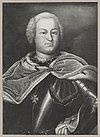
|
11 November 1706
Siegen
Son of Frederick William Adolf and Elisabeth Juliana Francisca of Hesse-Homburg
|
13 February 1722 – 2 March 1734
|
Principality of Siegen
(Protestant branch) |
Sophie Polyxena Concordia of Sayn-Wittgenstein-Hohenstein
23 September 1728
five children
|
11 November 1734
Siegen
aged 27
|
| Nassau-Siegen was annexed by Nassau-Dillenburg and Nassau-Dietz
|
| Frederick Louis
|

|
13 November 1651
Ottweiler
Son of John Louis and Dorothea Catherine of Palatinate-Birkenfeld-Bischweiler
|
9 February 1690 – 6 December 1723
|
County of Ottweiler
|
Christiane van Ahlefeldt
28 July 1680
eight children
Louise Sophie of Hanau-Lichtenberg
27 September 1697
no children
|
25 May 1728
Saarbrücken
aged 76
|
Count of Nassau-Ottweiler (1680–1728), in Rixingen (1703–28), Idstein (1721–28), and in Wiesbaden, etc. (1723–28). In 1723 inherited Saarbrücken, reuniting Ottweiler with the newly inherited land. After his death, Saarbrücken briefly mergen with Nassau-Usingen.
|
| 6 December 1723 – 25 May 1728 |
County of Saarbrücken
|
| Nassau-Ottweiler merged again in Nassau-Saarbrücken
|
| Christian |

|
12 August 1688
Dillenburg
Eighth son of Henry and Dorothea Elizabeth of Brieg
|
21 September 1724 – 28 August 1739
|
Principality of Dillenburg |
Isabella Charlotte of Nassau-Dietz
1725
no children
|
28 August 1739
Straßebersbach
aged 51 |
Left no surviving descendants and his lands were inherited by Nassau-Dietz and catholic Nassau-Siegen.
|
| Nassau-Dillenburg was inherited by Orange-Nassau (Nassau-Dietz) and catholic Nassau-Siegen
|
| Regency of Charlotte Amalia of Nassau-Dillenburg (1718-1734)
|
Sons of William Henry. Charles was the only heir, but in 1741 he divided the inheritance, and gave Saarbrücken to his brother (raised as a principality), and retained Usingen.
|
| Charles |

|
31 December 1712
Usingen
First son of William Henry, Prince of Nassau-Usingen and Charlotte Amalia of Nassau-Dillenburg
|
14 February 1718 – 21 June 1775
|
Principality of Usingen |
Christine Wilhelmine of Saxe-Eisenach
26 December 1734
four children
Magdalene Gross of Wiesbaden
after 1740
(morganatic)
four children
|
21 June 1775
Biebrich
aged 62
|
| William Henry |

|
6 March 1718
Usingen
Second son of William Henry, Prince of Nassau-Usingen and Charlotte Amalia of Nassau-Dillenburg
|
1735 – 24 July 1768
|
Principality of Saarbrücken |
Sophie Erdmuthe of Erbach-Erbach
28 February 1742
Erbach
five children
|
24 July 1768
Saarbrücken
aged 50
|
| Regencies of Anne of Great Britain (1751-1759, Marie Louise of Hesse-Kassel (1759-1765), Louis Ernest, Duke of Brunswick-Bevern (1759-1766) and Carolina of Orange-Nassau (1765-1766)
|
Also Hereditary Stadtholder of the Netherlands.
|
| William V |

|
8 March 1748
The Hague
Son of William IV and Anne of Great Britain
|
22 October 1751 – 9 April 1806
|
Principality of Dietz
(with Barony of Breda;as Orange-Nassau) |
Wilhelmina of Prussia I
4 October 1767
Berlin
five children
|
9 April 1806
Braunschweig
aged 58
|
| Charles Christian |
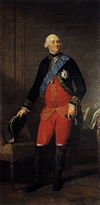
|
16 January 1735
Weilburg
Son of Charles August and Augusta Friederike of Nassau-Idstein
|
9 November 1753 – 28 November 1788
|
County of Weilburg |
Carolina of Orange-Nassau
5 March 1760
The Hague
fifteen children
Barbara Giessen
2 October 1788
(morganatic)
no children
|
28 November 1788
Münster-Dreissen
aged 53 |
|
| Louis |

|
3 January 1745
Saarbrücken
Son of William Henry and Sophie Erdmuthe of Erbach-Erbach
|
24 July 1768 – 2 March 1794
|
Principality of Saarbrücken |
Wilhelmine of Schwarzburg-Rudolstadt
30 October 1766
Schwarzburg
one child
Katharina Kest
28 February 1787
(morganatic, legitimized 1787)
seven children
|
2 March 1794
Aschaffenburg
aged 49 |
|
| Charles William |

|
9 November 1735
Usingen
First son of Charles and Christine Wilhelmine of Saxe-Eisenach
|
21 June 1775 – 17 May 1803
|
Principality of Usingen |
Caroline Felizitas of Leiningen-Dagsburg
16 April 1760
one child
|
17 May 1803
Biebrich
aged 67
|
Left no descendants. He was succeeded by his brother.
|
| In 1783, the heads of various branches of the House of Nassau sealed the Nassau Family Pact (Erbverein) to regulate future succession in their states, and to establish a dynastic hierarchy whereby the Prince of Orange-Nassau-Dietz was recognised as President of the House of Nassau.[7]
|
| Henry Louis |

|
9 March 1768
Saarbrücken
Son of Louis and Wilhelmine of Schwarzburg-Rudolstadt
|
2 March 1794 – 27 April 1797
|
Principality of Saarbrücken |
Marie Françoise Maximilienne of Saint Mauris-Montbarrey
6 October 1785
no children
|
27 April 1797
Cadolzburg
(aged 29)
|
After his death Nassau-Saarbrücken was occupied by France.
|
| Nassau-Saarbrücken was annexed by France
|
| Frederick Augustus
|

|
23 April 1738
Usingen
Second son of Charles and Christine Wilhelmine of Saxe-Eisenach
|
17 May 1803 – 24 March 1816
|
Principality of Usingen
|
Louise of Waldeck and Pyrmont
9 June 1775
seven children
|
24 March 1816
Wiesbaden
aged 77
|
From 1806 ruled jointly. Frederick William retained the title of Prince of Nassau, and Frederick Augustus maintained his title of Duke.
|
| 30 August 1806 – 24 March 1816 |
Duchy of Nassau
|
| Nassau-Usingen united with Nassau-Weilburg to form the Duchy of Nassau
|
| Frederick William
|

|
25 October 1768
The Hague
Son of Charles Christian and Carolina of Orange-Nassau
|
28 November 1788 – 9 January 1816
|
County of Weilburg
|
Louise Isabelle of Kirchberg
31 July 1788
Hachenburg
four children
|
9 January 1816
Weilburg
aged 47
|
| 30 August 1806 – 9 January 1816 |
Duchy of Nassau
|
| Nassau-Weilburg united with Nassau-Usingen to form the Duchy of Nassau
|
| William VI |

|
24 August 1772
The Hague
Son of William V and Wilhelmina of
Prussia I
|
9 April – 12 July 1806
19 October 1813 – 31 May 1815
|
Principality of Dietz
(with Barony of Breda;as Orange-Nassau) |
Wilhelmina of Prussia II
1 October 1791
Berlin
six children
Henrietta d'Oultremont
17 February 1841
(morganatic)
no children
|
12 December 1843
Berlin
aged 71 |
Ascended 9 April 1806, and on 27 October his lands were annexed to the Duchy of Nassau. He revived the Principality of Orange-Nassau, but in 1815 was proclaimed King of the Netherlands. His Nassau lands returned to the Duchy of Nassau. See List of monarchs of the Netherlands for extended information on the descendants of William.
|
| In 1806 (and then again in 1815), Dietz and Breda were annexed to the Duchy of Nassau
|
| William |
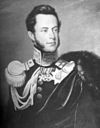
|
14 June 1792
Kirchheimbolanden
Son of Frederick William, Prince of Nassau-Weilburg and Louise Isabelle of Kirchberg
|
9 January 1816 – 24 March 1816
(as Prince of Weilburg)
24 March 1816 – 20 August 1839
(as Duke of Nassau) |
Duchy of Nassau |
Louise of Saxe-Hildburghausen
24 June 1814
Weilburg
eight children
Pauline of Württemberg
23 April 1829
Stuttgart
four children
|
20/30 August 1839
Kissingen
aged 47 |
|
| Adolph |
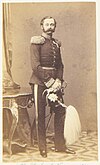
|
24 July 1817
Wiesbaden
Son of William and Louise of Saxe-Hildburghausen
|
20 August 1839 – 20 September 1866 |
Duchy of Nassau |
Elizabeth Mikhailovna of Russia
31 January 1844
St. Petersburg
no children
Adelheid-Marie of Anhalt-Dessau
23 April 1851
Dessau
five children
|
17 November 1905
Lenggries
aged 88
|
In 1866 lost his Nassau lands, but he was granted in 1890 the Grand Duchy of Luxembourg after the death of his 17th cousin without male descendants. See List of monarchs of Luxembourg for extended information on the descendants of Adolph.
|
| In 1866, Nassau was annexed to the Kingdom of Prussia
|




















